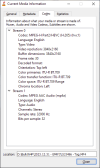I can understand a bit of what you're researching - then I wonder if the "flaws" in the configuration you mention affect the legibility of car registration plates ?
I understand correctly that "blurry, contoured mess in the image". will appear in places such as monotone areas of low contrast, clouds and sky. I wouldn't mind that kind of image compression.
If you really have deeper knowledge, don't communicate on the user forum, but directly to Viofo support. They may be able to explain to you if this is something they can influence, and if so, whether your reasoning is going in the right direction.
I would still ask if this level of firmware is not managed by Sony ?
===== edit
I'll stop with one more of your statements ... Does this mean you are using a 4k dascam in ful HD setting? But that completely degrades the features and functions of the camera, yes ?
Could this degradation of full HD footage on a 4k camera be related to bitrate limits ?
The other thing is whether the compression mechanisms are defined by the Viofo firmware or by the parts that Sony creates ?
Is even the "degraded" full HD video footage in the H.265 codec ?
It does affect registration plates. "How?" is of question. Also, the parameters do seem tuned for this, but it is too soon to tell atm.
Except these areas are created and not naturally occurring. Think turning real life to an anime, that's what is being done effectively.
Vantrue is the manufacturer of this camera using a Novatek SoC/ISP and Sony & other manufacturers' sensors
I have to get past the support desk staff. Since the forums here tend to be read and have direct, non-support employees viewing the forum's content, I chose to pose the premise here. HEVC is similar to JPEG compression by some measure as the same principles apply. This is why I did some controlled tests for just that. I could ask them how the data structures are defined. They likely won't answer me. There is probably a default that is generally advised and they did some tuning here and there. It is a massive amount of work to do this kind of thing. More on this later.
It's not, as the config file that
Dex_ posted shows filled out parameters for these settings very directly.
No, I'm using the 4K sensor to output to 4K and viewing it on a 1080p screen, aka half of the size, and observing various aspects of the image.
For fine detail, if much was left over after the oversharpening and over denoising.
The encoder's parameters are defined in software, not embedded in a binary in the firmware. The post I quoted from Dex_ lists the encoding parameters. Please read the thread.
Yes, it is:

From my time in H.264 via the x.264 encoder, I built a near real time DVR with an Intel Q6600 CPU for OTA TV which took MPEG-2 and turned that into H.264, you can get a very decent 1080p frame and video file in 7-10 Mbps. The encoding will not be in real time and there are other shortfalls. H.265 is more precessor/processing intensive with greater efficiency, something around ~25% lower bitrate for the same visual quality. Additionally, since encoding with these codecs is not dealing with pixels directly, but instead macro blocks, file size does not scale linearly with the area of the frame, i.e. 4K has 4 times the pixel count as 1080p. It instead scales with the width/height of the frame, thus a 4K frame of the same visual quality only requires twice as many bits as a 1080p frame because the height and width are only 2x that of a 1080p frame.
Moreover, this is a rule of thumb. Due to the computational power of the Novatek SoC/ISP in addition to the hardware implementation of the encoding mechanism, it isn't likely going to be possible to make a 4K video file @ 20 Mbps look better than the 32Mbps stream we're already getting. I won't be able to discern what those limitations are until I can at least figure out the 3DNR/temporal noise reduction. At the moment, I presume that it is looking at a half of a second of footage, 15 frames precisely, to do its job, based on a possible structure of the data currently in config file.
Back onto the topic of "the manufacturer knows best" look at sports footage as the prime example in the world for how this is done. Noise is removed, video is lossy-encoded in a low [processing power] effort manner (though some markets have upgraded from MPEG-2 to H.264 for broadcast), people see the edges of macro blocks and "mosquito noise" from the compression, and turn on smoothing options in the TV and then over-compensate with the sharpness because they don't want to admit their eyesight is going bad. A good primer exists on
Wikipedia.

